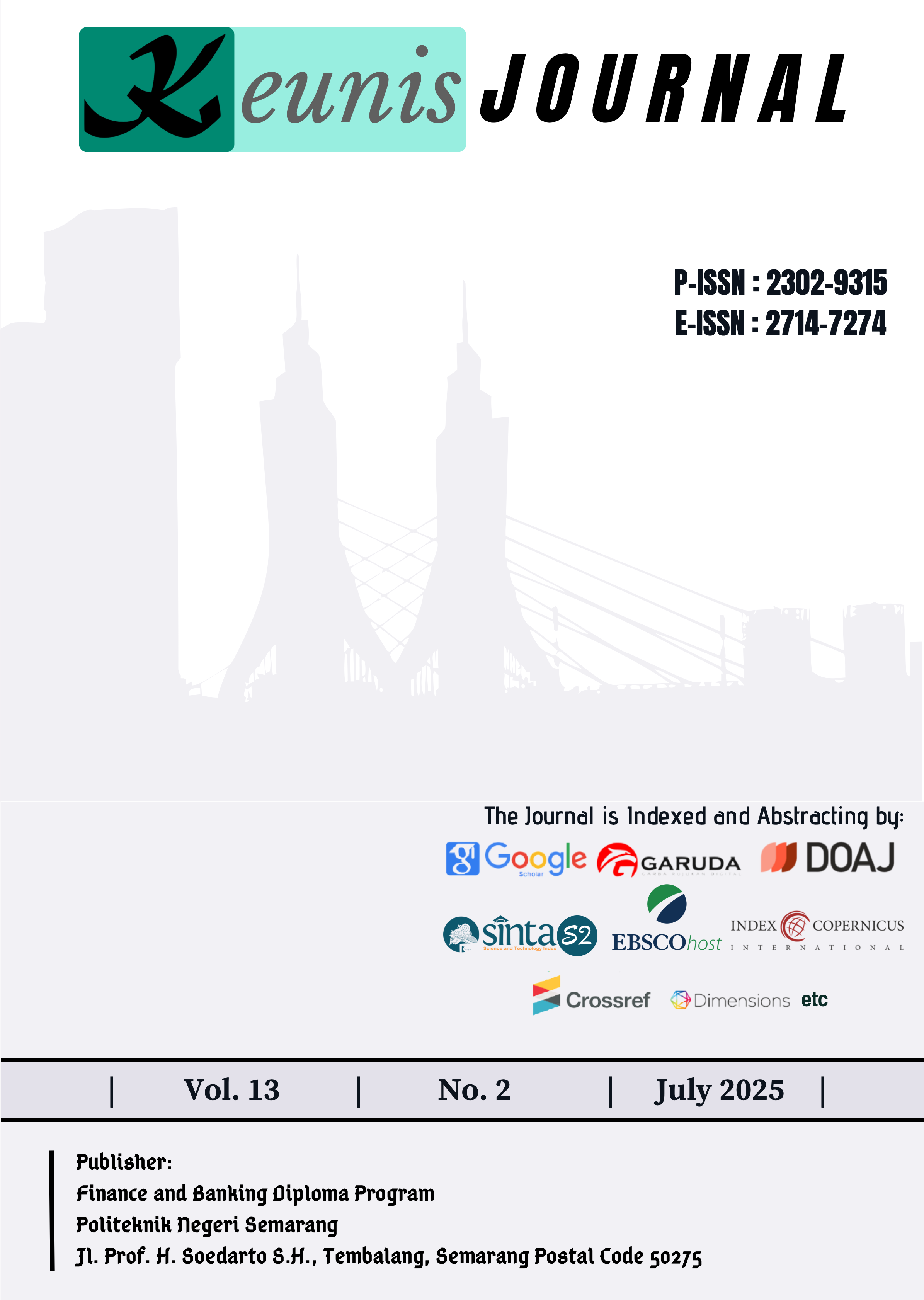Moderating Role of Community Participation in the Relationship between Organizational Commitment, Good Corporate Governance, and Apparatus Performance
DOI:
https://doi.org/10.32497/keunis.v13i2.6432Keywords:
organizational commitment, good corporate governance, community participation, apparatus performance, village fund managementAbstract
This study aims to analyze the influence of organizational commitment and Good Corporate Governance (GCG) on the performance of village officials, and to test the moderating role of community participation in the relationship. This study uses a quantitative approach with a survey method, involving 72 respondents consisting of officials and the community in Pakisaji District, Malang Regency. The data analysis technique uses Moderated Regression Analysis (MRA). The results of the study indicate that organizational commitment and the implementation of GCG principles have a significant effect on improving the performance of officials. Community participation also has a positive effect on the performance of officials, and significantly moderates the relationship between organizational commitment and official performance. However, community participation does not significantly moderate the relationship between GCG and official performance, indicating that the effectiveness of participation depends on the quality and structure of community involvement. These findings provide empirical contributions to the development of participatory and accountable village governance, as well as strengthening the role of internal and external factors in driving official performance.
References
Al Hussain, A., & Johnson, R. (2009). Corporate governance structures: Theory and practice. Journal of Governance, 15(3), 123–139.
Alhasnawi, M., Zayed, H., & Sulaiman, S. (2023). Community participation in sustainable development: Exploring its impact on local decision-making processes. Journal of Public Policy and Governance, 18(2), 99–112.
Anshori, M., & Dewi, L. (2021). The Community as a Work Partner: Public Participation and Its Implications for the Performance of Regional Government Apparatus. Journal of Public Administration Science, 10(1), 67–76.
Arnstein, S. . (1969). A ladder of citizen participation. Journal of the American Institute of Planners, 35(4), 216–224.
Astuti, S. (2024). The influence of work motivation, organizational commitment, and work environment on the performance of village officials in Seluma Selatan District. Dehasen University Bengkulu.
Bru Netto, L., Gonzalez, L., & Martin, M. (2022). Psychosocial safety climate and its impact on employee well-being: A comprehensive study. Journal of Occupational Health and Safety, 45(2), 112–123.
Chompunth, C., Lee, S., & Tan, R. (2022). Community participation in local governance: Approaches, challenges, and outcomes. Journal of Public Administration and Social Policy, 19(2), 120–133.
Davis, J. ., Kelly, M. ., & Williams, P. . (1997). The role of public servants as servants to the public. Public Administration Review, 57(2), 199–208.
Donaldson, L. (2001). The contingency theory of organizations.
Donaldson, T., & Preston, L. E. (1995). The stakeholder theory of the corporation: Concepts, evidence, and implications. Academy of Management, 20(1), 65–91.
Dwiyanto, A. (2006). Realizing good governance through public services. Gajahmada University Press.
Elisa, Widodo, S., & Nasution. (2022). Pengaruh kemampuan kerja dan komitmen organisasi terhadap kinerja aparatur sipil negara (ASN) Kota Bengkulu. Student Journal of Business and Management, 5(1), 521–540.
Fauziah, A., & Nugroho, H. (2024). The Role of Good Corporate Governance in Enhancing Civil Servants’ Performance in Central Government Institutions. Policy. Journal of Governance and Public Policy, 13(1), 78–89.
Freeman, R. E. (1984). Strategic Management: A Stakeholder Approach.
Hessari, A., Jafari, S., & Sadeghi, A. (2023). Technostress and its impact on employee performance: A systematic review. Journal of Business and Technology, 59(1), 45–60.
Jensen, M. ., & Meckling, W. . (1976). Theory of the firm: Managerial behavior, agency costs, and ownership structure. Journal of Financial Economics, 3(4), 305–360.
Khosrowjerdi, M. (2022). The role of corporate culture in enhancing organizational performance: A case study in the manufacturing sector. Journal of Business and Organizational Behavior, 14(3), 75–88.
Kiongo, S., & Moi, M. (2023). The role of community participation in local governance: Lessons from rural areas. Journal of Social Development and Policy, 17(2), 78–90.
Lau, D. C., & Murnighan, J. . (2008). Demographic diversity and faultlines: The compositional dynamics of organizational groups. Academy of Management Review, 33(2), 325–349.
Lestari, D., & Hidayat, R. (2024). Organizational commitment and its influence on employee loyalty in the public sector. Journal of Administration and Organization, 16(1), 45–53.
Levy, K., Chasalow, K. ., & Riley, S. (2021). Algorithms and decision-making in the public sector. Annual Review of Law and Social Science, 17, 309–334. https://doi.org/https://doi.org/10.1146/annurev-lawsocsci-041221-023808
Li, X. (2025). ESG performance in modern firms: Analysis and implications. Journal of Sustainability Management, 22(1), 50–70.
Maulana, A. (2025). Organizational commitment as a determining factor of employee performance in the digital era. Journal of Management and Business Sciences, 18(1), 12–20.
Maulana, R., & Fitriani, D. (2023). The Effect of Community Participation on Transparency and Village Government Apparatus Performance. Journal of Public Policy and Services, 12(2), 101–110.
McClinton, R., Johnson, L., & Williams, P. (2018). Psychological safety climate in organizations: A comprehensive review. Journal of Occupational Health Psychology, 23(4), 445-457. Journal of Occupational Health Psychology, 23(4), 445–457.
Meyer, J., & Allen, N. J. (1991). A three-component conceptualization of organizational commitment. Human Resource Management Review, 1(1), 61–89. Human Resource Management Review, 1(1), 61–89.
Miao, Y. (2023). Public participation in decision-making: Approaches and challenges. Journal of Politics and Public Policy, 18(4), 102–118.
Nguyen, T., Tran, H. ., & Pham, V. T. (2024). Nguyen, T. P., Tran, H. L., & Pham, V. T. (2024). Community participation in sustainable urban development: A case study of Vietnamese cities. Journal of Urban Studies, 25(1), 50–63. Journal of Urban Studies, 25(1), 50–63.
Nosratabadi, M., Shafie, L. ., & Sadeghi, S. (2020). Cultural intelligence and leadership: A review of the literature. A Review of the Literature. Journal of Business Research, 192–205.
Permata Dewi, A. (2023). Kemendes PDTT dorong Program Akuntabilitas Dana Desa. Antara News.
Pratama, H. . (2024). The effect of Good Corporate Governance (GCG) implementation on company performance in the banking sector. Journal of Management and Finance, 18(1), 45–58.
Purnamasari, I., & Suganda, F. R. (2021). Pengaruh komitmen organisasi dan locus of control terhadap kinerja aparatur Kecamatan Garut Kota. Journal of Knowledge Management, 15(2), 62. https://doi.org/https://doi.org/10.52434/jkm.v15i2.2135
Putri. (2024). Good Corporate Governance (GCG). Journal of Management and Governance, 10(2), 45–59.
Putri, N., & Susilowati, I. (2021). Commitment of village officials in transparent and accountable village financial management. Journal of Public Administration and Policy, 8(1), 22–30.
Rachmawati, Y., & Baridwan, Z. (2021). The role of good corporate governance in improving financial performance: A study of Indonesian companies. Journal of Accounting and Finance, 23(1), 35–48.
Radar, M. (2024). Head of Wadung Village, Pakisaji, arrested for alleged embezzlement of IDR 646 million in village funds. https://radarmalang.jawapos.com.
Rahayu, S., & Santoso, D. (2023). The effect of organizational commitment on employee performance in government agencies. Journal of Management and Organization, 15(1), 55–64.
Ramadhan, R., & Yuliana, S. (2021). Implementation of Good Corporate Governance and Its Impact on Civil Servants’ Performance in Sleman Regency. Journal of Administrative Reform, 8(2), 134–143. Journal of Administrative Reform, 8(2), 134–143.
Rilah, & Ningsih, T. (2024). The influence of corporate culture on employee performance in technology companies. Journal of Management and Business, 21(2), 123–135.
Siregar, M., & Kurniawan, B. (2022). Good Corporate Governance as a Determinant of Civil Servants’ Performance. Journal of Bureaucracy and Government, 11(1), 55–64.
Suchman, M. C. (1995). Managing legitimacy: Strategic and institutional approaches. Academy of Management Review, 20(3), 571–610.
Susanto, H., & Ayuningtyas, V. (2025). Community Engagement and Bureaucratic Performance: A Study of Local Government Services in Indonesia. Journal of Public Sector Innovation, 14(1), 45–58.
Triutami, S., & Widarno, W. (2024). The influence of community participation, good governance implementation, apparatus competence, and supervision on the effectiveness of village fund management. Journal of Government Studies, 15(1), 45–60. https://doi.org/https://doi.org/10.xxxx/jgs.v15i1.xxxx
UNDP. (1997). Governance for Sustainable Human Development. United Nations Development Programme.
Vroom, V. . (1964). Work and motivation.
Wendler, A. (2024). Community participation in decision-making processes: A study of urban and rural disparities. Journal of Public Policy and Participation, 22(1), 50–65.
Wibowo, A., & Arumsati, N. (2022). The effect of affective commitment on employee performance in the public sector. Journal of Psychology and Management, 10(2), 101–110.
Zuhri, M. (2022). The role of community participation in village development: A case study in urban areas. Journal of Community Development, 11(3), 180–195.
Downloads
Published
Issue
Section
License
Copyright (c) 2025 The Author(s)

This work is licensed under a Creative Commons Attribution-NonCommercial-ShareAlike 4.0 International License.
KEUNIS is licensed under a Creative Commons Attribution-ShareAlike 4.0 International License.
Authors who publish with this journal agree to the following terms:
- Authors retain copyright and grant the journal right of first publication with the work simultaneously licensed under a Creative Commons Attribution-ShareAlike 4.0 International License that allows others to share the work with an acknowledgement of the work's authorship and initial publication in this journal.
- Authors are able to enter into separate, additional contractual arrangements for the non-exclusive distribution of the journal's published version of the work (e.g., post it to an institutional repository or publish it in a book), with an acknowledgement of its initial publication in this journal.
- Authors are permitted and encouraged to post their work online (e.g., in institutional repositories or on their website) prior to and during the submission process, as it can lead to productive exchanges, as well as earlier and greater citation of published work (See The Effect of Open Access).






